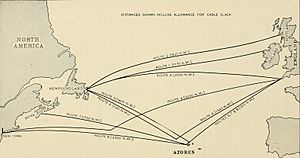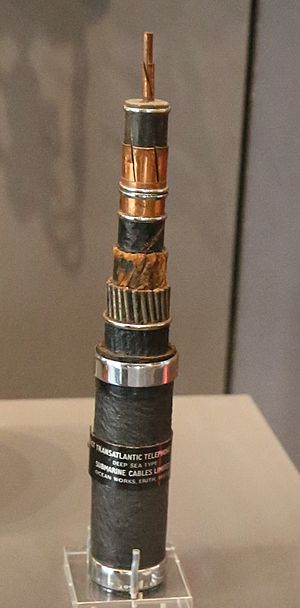TAT-1 facts for kids
TAT-1 (which stands for Transatlantic No. 1) was a very important underwater cable system. It was the first one that allowed people to make phone calls across the Atlantic Ocean. This special cable connected Oban, Scotland, to Clarenville, Newfoundland, in Canada.
Workers laid two separate cables between 1955 and 1956. One cable carried calls in one direction, and the other carried calls in the opposite direction. The TAT-1 system officially started working on September 25, 1956. It could handle 35 phone calls at the same time. There was also a 36th channel that could carry up to 22 telegraph messages.
How Phone Calls Crossed the Ocean
Before TAT-1, making a phone call across the Atlantic was difficult. The first underwater cable was for sending telegraph messages, not voices. That cable was laid way back in 1858. It only worked for about a month, but a better one was put in place in 1866.
For phone calls, people used a radio service that started in 1927. It was very expensive, costing about £9 for just three minutes! People talked about building a phone cable then, but the technology wasn't ready.
Making TAT-1 Possible
Several big inventions in the 1940s made TAT-1 a reality. These included:
- Coaxial cables: These are special cables that can carry many signals at once.
- Polyethylene insulation: This plastic material helped protect the cables underwater.
- Reliable vacuum tubes: These were used in special devices called repeaters.
- Better carrier equipment: This helped send the phone signals clearly.
Repeaters were super important. They were placed along the cable deep underwater. Their job was to boost the phone signals so they wouldn't get too weak over the long distance. Imagine them as mini-amplifiers for your voice!
Interestingly, transistors were a new invention at the time. But engineers didn't use them for TAT-1 because they weren't sure how long they would last underwater. They needed something super reliable for such a big project.



